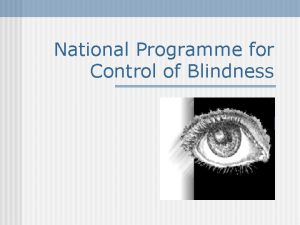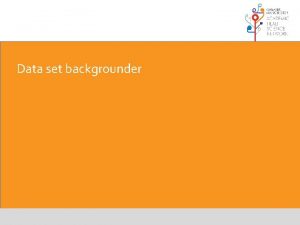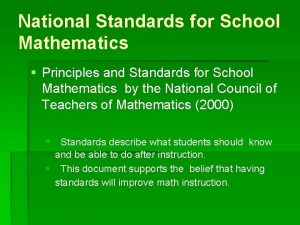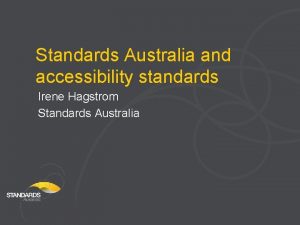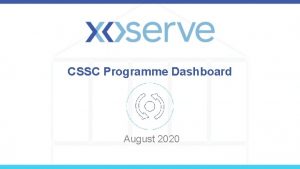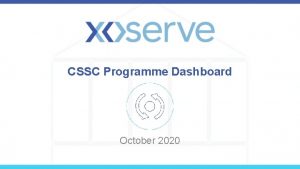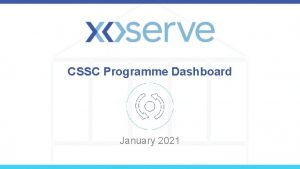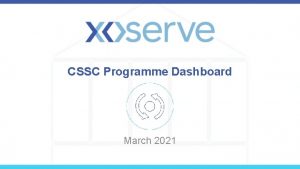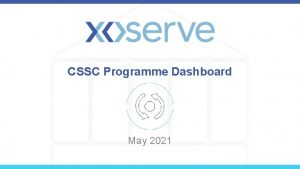National Programme on School Standards and Evaluation Shaala






























- Slides: 30

National Programme on School Standards and Evaluation Shaala Siddhi An Initiative Towards School Improvement Prof. Pranati Panda Unit on School Standards and Evaluation National Institute of Educational Planning and Administration (NIEPA) New Delhi-110016 1 pranatipanda@nuepa. org, pranatipanda@gmail. com

School Self-Evaluation • Self-Evaluation is considered as the nucleus of the school evaluation process. • It facilitates the school to evaluate its critical performance areas. • The school needs to follow the guideline to make accurate professional judgment. • The guideline is intended to facilitate the school selfevaluation process in a sequential and guided manner. 2

Key Questions School Should Reflect Upon Before Proceeding For Self-evaluation • • • How is our school currently performing? What are our school strengths? Which are the areas requiring improvement? What evidence do we have to know the current status? How can we evaluate the performance of our school? What measures can we take for improving our school performance? 3

Objectives of School Self-Evaluation The school self-evaluation intends to: • Prepare and empower the school to recognize its strengths and areas of improvement in a planned and guided manner; • Create a collaborative culture with the active participation of all stakeholders for making professional judgment and decisions; • Facilitate the school for continuous engagement and provide direction for incremental actions. 4

Who will do the School Self-Evaluation? • School as a whole should engage in the selfevaluation process. • All the stakeholders including Head Teacher/ Principal, teachers, students, parents, members of the SMC/SDMC, and members of the immediate community should participate in the self-evaluation process. • During the self evaluation process the school may consult the respective stakeholders of relevant areas to take specific decisions. 5

What is the Duration of the Self-evaluation Process and Uploading Dashboard in the Web Portal? • Self-evaluation should be considered as a continuous process. • It is most effective when it is integrated into the day to day functioning of the school. • The duration of the self-evaluation process may range from 2 -6 months according to the context, size and need of the school. • All the schools are expected to complete the self-evaluation process and upload the Dashboard as and when they are ready. However, all the schools need to comply with the deadline for the self-evaluation process as decided by the state. 6

Process of School Self-Evaluation Building Preparedness: Building preparedness is an essential prerequisite of the school self-evaluation process. The school should reflect and act upon the following points to prepare itself for selfevaluation process. 1. The objectives of school self-evaluation and its long-term advantages for school improvement should be discussed amongst all the stakeholders; 2. All members of the School should read the Framework critically and understand it in true spirit; 3. The school should provide opportunities for open and frank discussion; 4. The school may consult relevant and mandated policies, government orders, etc. and the initiatives undertaken by the state; 5. Transparency and objectivity should be emphasized. 7

Step – 1: Initiating Self-Evaluation Process for Key Domains In order to initiate the self-evaluation process, the school should: • Initiate the deliberations on each key domain separately; • Deliberate upon the introduction of each key domain, discuss its significance and structure; • Discuss the reflective prompts which are broad based questions to prepare them for a robust self-evaluation process; • Fill up the factual information of each key domain; the factual information is meant for self-use of the school; • Understand analyse the significance of each core standard as a measurable point under the respective key domain; • Interpret the core standards by using descriptors written in a hierarchical manner (Level 1 -2 -3) 8

Step – 2: Making Professional Judgment 1. School should make a judgment against each core standards by referring to both factual information as well as sources of evidence; 2. School should collect and refer to source of evidence on the basis of which it can decide the level. It should also compile a list of the sources of evidence used to support its decision under the following categories: • Referential Evidence (Norms/Guidelines/Register/Government orders) • Supportive evidence available in the School • Evidences that a school needs to create (Class room observation, capturing the voices of learners, parents and SMC); 3. School should make judgment of placing itself at a particular level of a core standard by analysing the descriptors, and while doing so refer to factual information and sources of evidence for ascertaining its level. 4. School should take a collective decision while placing itself at any particular level of a core standard. 9

Step – 3: Response Matrix Identifying and Recording Status of School Functioning • • • School needs to record its judgment in the Response Matrix provided for each Key Domain. The Response Matrix would thereby provide a complete picture of the level at which the school is currently functioning in the respective key domain. Referring to the response matrix of each key domain, school should identify the area of improvement and prioritize them as low, medium and high (L/ M/ H). (Note: The decisions related to prioritization will depend on the immediate needs of the school, requirements of government policies, local situations and the school’s own constraints and resources). Accordingly the school should propose action/s it would take over the next three years (year 1, 2 and 3) for improving with respect to a particular core standard. School should identify the area of improvement against each core standard. For this the, school should emphasise on the gaps in the level it has marked itself at and also select the action/s required for improvement from the higher level/s. School should record innovation/s undertaken, if any, if - its performance level against any core standard is even beyond/ higher than level 3 - it follows any other innovative practices relating to the domain; School should use the factual information, filled in response matrix and planning for improvement table as records for filling up the Dashboard. 10

Step – 4: Filling up School Evaluation Dashboard in Hard Copy Please keep the hard copy of the Dashboard in your school along with domain specific Information 4. 1. Basic Information of the School The basic information of the school is an essential pre requisite to derive an overview of the school. The basic information about learners, learning outcomes and teachers are interlinked to the key performance areas of the school. 11

4. 1. 1. Basic Information of the School: Demographic Profile • Learners’ demographic profile provides a holistic picture of the social, economic and cultural composition of learners of the school. It promotes the culture of understanding the type of learners attending the schools. • School should provide the number of the students belonging to SC, ST, OBC, General and Minority. The number of minority students should not be added to the total. 12

4. 1. 1. Basic Information of the School: 4. 1. 2. Basic Information of the School: Demographic Profile Learners’ Profile & Learning Outcomes • Learning outcomes determine the progress, development and attainment of the learners. It is also an important determinant for reflecting the performance level of the school. • School should provide the learning outcomes of the learners against each class by calculating the percentage and placing them under respective ranges. (<33, 33 -40, 41 -50, 51 -60, 61 -70, 71 -80, 81 -90, 91 -100 ) ) For e. g. if there are 50 students in class Ist and out of 52 students (four per cent) have got 10 (20 per cent) and 12 (24 per cent) marks. That would mean that 4 per cent students fall in the category of below 33 per cent marks. • The learning outcomes should be based on the Annual consolidated report (Final Results of one academic year). • For example, if the school is filling up the Dashboard at any time or any month of an academic year, it is mandatory for the school to use only available final annual consolidated reports (Report of previous academic year). 13

4. 1. 3. Basic Information of the School: Class wise annual attendance rate • The annual attendance rate reflects the consistency of learners in attending and participating in the schooling process. The attendance of learners is closely linked to their progress, attainment and all round development; • The school should calculate the class-wise annual attendance rate of the students (boys and girls separately) from attendance registers. • The school should provide class wise annual attendance of all students. For Example, if the school is filling up the Dashboard at any time or month of an academic year, it is mandatory for the school to refer to the annual attendance of the students’ referring to the attendance records of the previous academic year. 14

Example for Attendance Rate calculation Suppose, • The total Number of prescribed Instructional Days = 220 • Total Annual Attendance of 50 students of a particular class = 9850 • No. of Boys =30, Total Annual Attendance of Boys = 6200 • No. of Girls = 20 Total Annual Attendance of Girls = 3650 Note: Annual attendance rate of boys and girls will be calculated separately # Attendance rate is the average attendance of all the students on all the instructional days of the school. # Class wise annual attendance rate reflects the consistency of learners in attending the school. It is also important because students are more likely to succeed in academics when they attend school consistently. 15 # Thus the annual attendance rate directly impacts the learning outcomes of the class as a whole.

4. 1. 4. Basic Information of the School: Performance in Key Subjects Rationale • The performance in key subjects (Annual) reflects the relative achievement of the students across the key subjects; • It also provides information on the subject/s in which the school is consistently showing low performance and may need improvement; • It is also closely linked to the overall performance of the school across all domains; Instructions: School should provide the total number of students along with the percentage of students’ performance in key subjects/streams namely Language I, Language II, Math, Science and Social Science by placing the percentages of students under each grade (A, B, C, D, E) according to the criteria given below : • • • Criteria to fill in grade-wise performance of students Grade A: percentage of students who have achieved 81 – 100 marks in key subjects Grade B: percentage of students who have achieved 61 – 80 marks in key subjects Grade C: percentage of students who have achieved 41 – 60 marks in key subjects Grade D: percentage of students who have achieved 33 – 40 marks in key subjects 16 Grade E: percentage of students who have achieved 00 – 32 marks in key subjects

4. 1. 5. Basic Information of the School: Teachers’ Profile Rationale • Teachers’ professional training is critical for ensuring quality of school education and is the most important school-based determinant of students’ academic success; • The teachers’ absence from the school for any reason- be it any kind of leave that is officially sanctioned , on duty, for attending training or is unauthorized impact the learners’ performance and overall school performance. Instruction • All the teachers, regular as well as contractual, are to be considered for providing information under the male and female category; • School should provide the number of teachers in each category currently serving in the school: a) Male (Trained and Untrained); b) Female (Trained and Untrained), c) Total (Trained and Untrained) # Trained teacher are those who have a degree or a diploma in teaching as per NCTE norms. • In the long leave (more than one month) category , the school has to provide information about the number of teachers who have availed total leave of one month or more at a stretch or in parts during the previous academic year; • For the short leave (up to one week) column, the school should specify number of teachers who have availed leave up to one week or up to one month at a stretch or in parts during the previous academic year. 17

4. 2. Evaluation Composite Matrix Rationale: • The school evaluation Composite Matrix provides the consolidated performance of the school across the seven key domains; • The composite matrix should be viewed interlinking it with the basic information of the school for a comprehensive understanding of its performance level; • The composite matrix also enables and empowers the school to manage the change process through prioritisation of core standards. Instruction: • The school should fill up only the ‘Self’ column in the composite matrix ; • School should fill up the level (Level 1 -2 -3) against each core standard by referring to the response matrix of the respective Key Domain; • The school should fill up the ‘Prioritize the area of Improvement’ column by referring to the ‘Planning for Improvement’ table of each Key domain. 18

4. 3. Action for Continuous School Improvement Plan (ACSIP) This part of the Dashboard focuses on actions to be undertaken by the school to move towards the goal of school improvement. 19

4. 3. 1. Mission Statement As a follow-up to school self-evaluation, the school should articulate and write the ‘Mission Statement’. Mission statement of the school is a collective perspective to set the achievable goals for improvement. Rationale Mission Statement sets the achievable goals and provides direction for the same. Instruction The mission statement should be: • written on the basis of school self-evaluation ; • of two or three lines( 20 to 50 words) ; • Revisited and updated annually. 20

4. 3. 2. Area of Improvement The Shaala Siddhi programme visualizes ‘School evaluation as the means and school improvement as the goal’. In order to translate this, the school is expected to highlight the areas of improvement. While emphasizing the area of improvement, the school should take a collective perspective based on the prioritization of the core standards of the respective key domains, the mission statement, and possible action school can undertake and with the support of system and concerned officials. Instruction • Based on the prioritisation of the core standards (High , Medium and Low ) under respective key domains , school should propose the area of improvement; • The school should further collectively identify the specific core standards that may need immediate action and are achievable within the defined time line; • Some of the areas of improvement may require short time while others may take longer to bring improvement. 21

4. 3. 3. Proposed Action Rationale The proposed action refers to the defined activities through which the school can bring improvement. Instruction • The proposed action should be realistic and feasible; • The higher level/s descriptor of the core standard must be used for proposing action; 22

4. 3. 4. Support Needed Rationale • School as a dynamic institution requires continuous support for its improvement. Support to the • school on the basis of its needs is essential for its nurturance also. Instruction • School should mention the specific support needed; • School should specify the support, if needed, from within and from cluster, blocks, districts, state level officials, neighboring schools and other institutions; • School may seek the support of the community and use other available resources 23

4. 3. 5. Action Taken Rationale The action taken refers to the steps taken to achieve the desired changes and improvement of the respective core standard. Instructions • The school should specify the action/s, if any, taken earlier in connection with the proposed action; • The school may specify any action that is already undertaken, is continuing, or has been initiated corresponding to the proposed action. • The school may take action as a continuous process in addition to proposed action. • In order to bring change and manage the school improvement process, school should also pronounce the action taken by them to achieve the improvement of levels of diverse core standards. 24

4. 4. Celebrating Change • The main tenet of the Shaala Siddhi initiative being ‘School Evaluation as the means and School Improvement as the goal’, it is important to celebrate change and initiate a culture of ensuring continuous improvement. This would not only motivate the school to continue on its journey of improvement but also encourage the larger community to imbibe this culture. In order to meet this end it is proposed that a special event be organized across the nation with all schools celebrating change during the same day/s. 25

Step – 5: Uploading School Evaluation Dashboard on the web portal Web address: www. shaalasiddhi. nuepa. org • Kindly refer to the User Manual for operating Shaala Siddhi Web portal for detailed information. • Kindly fill the hard copy of the dashboard for your convenience, before uploading the school Self-evaluation information on the Web Portal. Please follow these instructions while creating the User ID and generating PIN (OTP), Password. 26

Instructions • This website should be used only by authorized personnel of the school. • School has to insert URL http: //www. shaalasiddhi. nuepa. org in the address bar. • Home page of the web portal will appear on the screen. Step 1: • If you are a first time user click on new user • Schools should login only through the school level user. • Enter a valid 11 digit UDISE Code (Example: For School user eleven digit UDISE code). • Enter all mandatory fields. • To generate a Unique PIN (OTP), enter either Mobile No. or Email ID or Both. • After the successful PIN (OTP) generation, enter the valid PIN (OTP) that is received on your • Mobile No. /Email Id to proceed further. Note: If you don't receive PIN (OTP) within 120 seconds, click on Regenerate PIN (OTP) button. • Click on Submit. • If you have entered valid six digits PIN (OTP), you will be redirected to Step 2. • If the entered PIN (OTP) is invalid, you will be shown a message saying 'Invalid PIN (OTP)'. • Please save your login Id, Password and PIN (OTP) for future use. • In case you forget your password you can regenerate your password by entering your UDISE code and PIN (OTP) by clicking on ‘forget password’. Also note that if you forget your OTP kindly refer to your registered Mobile No. or Email ID. • If you are unable to recall your registered mobile No. or Email ID you can contact the administrator. 27

Instructions (Cont. . ) Step 2: • Enter new password and confirm new password. (Rule: Password length should be between 8 to 10 characters, must contain at least one lower case letter, one upper case letter, one digit and one special character. Allowed special characters are!@#$%^&*()+=. ) (Ex: Nav@2012). a) On successful creation of password, you will be redirected to home page. b) If the password entered does not confine to the Rule (Refer Point 5. 7), a validation message will be shown. c) After the successful creation of the password, schools can now click on the ICON on the left hand of their screen and sequentially fill up the Dashboard. d) For the successful completion of each step school needs to click on submit and then proceed to next. e) After the successful submission of each step, status will turn green on the Home icon. 28

Instructions (Cont. . ) Step 3: • Remember, after final submission, you cannot edit or change any edit the data after final submission they can contact the administrator and place a request to unfreeze the data by click on the manage user icon. • School users can save their self-evaluation report in various formats like PDF and Excel. • All web portal related queries can be emailed to usse@nuepa. org. 29

THAN K YOU 30
 Www.shaala siddhi.nuepa.org.in login
Www.shaala siddhi.nuepa.org.in login Shaala siddhi annual attendance rate
Shaala siddhi annual attendance rate How to fill shaala siddhi external evaluation
How to fill shaala siddhi external evaluation National programme related to child health and welfare ppt
National programme related to child health and welfare ppt Factors determining service standards
Factors determining service standards The national healthy childhood programme
The national healthy childhood programme Goals of ntep
Goals of ntep National programme on technology enhanced learning
National programme on technology enhanced learning National programme for health care of elderly
National programme for health care of elderly National health programme
National health programme National health programme
National health programme National mental health programme objectives
National mental health programme objectives National collaborative outreach programme
National collaborative outreach programme National leprosy eradication programme ppt
National leprosy eradication programme ppt National manufacturing competitiveness programme
National manufacturing competitiveness programme National iodine deficiency disorders control programme
National iodine deficiency disorders control programme National blindness control programme
National blindness control programme Nphce
Nphce National mental health programme
National mental health programme Conclusion of health and disease
Conclusion of health and disease Conclusion of health and disease
Conclusion of health and disease Stroke sentinel national audit programme
Stroke sentinel national audit programme Evaluation standards
Evaluation standards National institute of standards and technology
National institute of standards and technology What are the health services provided by school
What are the health services provided by school Pitlochry primary school online programme
Pitlochry primary school online programme Pitlochry primary school online programme
Pitlochry primary school online programme 10 importance of health education
10 importance of health education Pitlochry primary school online programme
Pitlochry primary school online programme Sharp in public health dentistry
Sharp in public health dentistry Streamü
Streamü
















